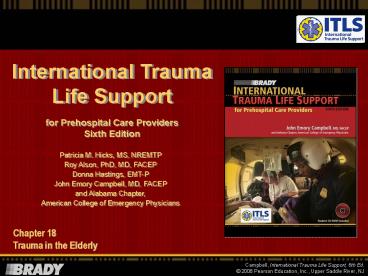Trauma in the Elderly - PowerPoint PPT Presentation
1 / 24
Title:
Trauma in the Elderly
Description:
Prolonged illness and recovery time. Decreased total body water ... bleeding time ... Many layers of clothing. Chronic disease vs. acute problem ... – PowerPoint PPT presentation
Number of Views:1518
Avg rating:3.0/5.0
Title: Trauma in the Elderly
1
Chapter 18 Trauma in the Elderly
2
Trauma in the Elderly
3
Overview
- Changes that occur with aging
- How changes affect assessment of geriatric trauma
- Assessment of geriatric trauma
- Management of geriatric trauma
4
Trauma in the Elderly
- Fatal outcomes more likely,even if injury
isrelatively low in severity.
5
Trauma in Elderly
- Age impairs bodys response.
- Trauma is major cause of death.
- Falls
- Fractures of hip, femur, wrist, and head injuries
- Motor-vehicle collisions
- Higher incidence of collision
- Thermal injury
- Inhalation, scalding, flame burns, electrical
injury
6
Trauma in Elderly
- Higher risk of injury
- Reflex response time increased
- Eyesight and peripheral vision decreased
- Hearing decreased
- Postural instability
- Arthritis
- Fragile skin and blood vessels
- Fragile bones
7
The Aging Body
- Airway
- Respiratory system
- Potential obstruction
- Decreased
- Pulmonary circulation 30
- Alveolar exchange
- Capacity and work rate
- Chest wall movement
- Inhalation time
- Vital capacity due to increased residual volume
8
The Aging Body
9
The Aging Body
- Cardiovascular system
- Congestive heart failure and pulmonary edema
- Circulation decreased
- Cardiac output and stroke volume decreased
- Conduction system degenerates
- Heart valve efficiency decreased
- Arteriosclerosis
- Peripheral vascular resistance increased
- Systolic hypertension
10
The Aging Body
- Neurological and sensory function
- Subdural hematoma
- Brain shrinks, dura mater adherent to skull
- Brain arteries harden, narrow, lose elasticity
- Unrecognized injury
- Blood flow to brain decreased
- Sensory responses decreased
- Pain tolerance increased
- Altered mental status
- Blood flow to brain decreased
11
The Aging Body
- Thermoregulation
- Hypothermia
- Temperature control mechanism deteriorates
- Subcutaneous tissue decreased
- Afebrile with infection
- Temperature control mechanism deteriorates
12
The Aging Body
- Renal system
- Immune system
- Drug toxicity
- Nephron function decreased
- Blood filtration decreased
- Infection
- Malnutrition
- Sepsis
- Immune response decreased
13
The Aging Body
- Musculoskeletal system
- Postural changes
- Kyphotic deformity of spine
- Slight flexion of knees and hips
- Muscle strength decreased
- Fractures
- Advanced osteoporosis
- Bone density decreased
- Subcutaneous tissue decreased
14
The Aging Body
- Gastrointestinal system
- Malnutrition
- Decreased ability to metabolize medications
- Overall system changes
- Prolonged illness and recovery time
- Decreased total body water leads to dehydration
15
Medications
- Drug interaction problems
- Anticoagulants increase bleeding time
- Antihypertensives and peripheral vasodilators
limit constriction response - Beta-blockers limit tachycardia response
16
Important Points
- General organ systems less effective.
- Especially cardiovascular, pulmonary, renal
- Chronic illness complicates trauma care.
- Difficult to distinguish
- Bones fracture more easily.
- Major bone fractures can be life-threatening
17
Assessment
- Do not underestimate severity.
- Die from less-severe injuries
- May not report important symptoms
- Pain response, hypoxia, hypovolemia varies
- Multiple illnesses
- Communications
18
ITLS Patient Assessment
- ITLS Primary and Secondary Surveys
- Anticipate complicating factors
- Peripheral pulses difficult to evaluate
- Many layers of clothing
- Chronic disease vs. acute problem
- Nonpathologic rales
- Loss of skin elasticity and mouth breathing
- Dependent edema
- Variation in normal vital signs
19
Scene Size-up
- Verify history with reliable bystander.
- Observe surrounding area.
- Indications that unable to provide own care
- Alcohol or medication abuse
- Signs of violence, abuse, neglect
- Notify proper authorities
- Gather medications and take to hospital.
20
Initial Assessment
- Initial level of consciousness
- Clarify normal level before trauma
- Preexisting condition or trauma
- Check blood glucose
- Chest injuries
- More likely serious
- Spinal precautions
- Arthritis and kyphosis
21
Critical Transport Decision
- Low threshold for early transport
22
Ongoing Exam
- Monitor IV fluid administration response.
- May precipitate congestive heart failure
- Frequently assess pulmonary status.
- Lung sounds
- Cardiac monitoring
- Pulse oximetry
- Capnography
- Do not withhold fluid if needed.
23
Summary
- Increasing number of elderly patients
- Evaluation and treatment more difficult
- Physiologic processes of aging
- Frequent concurrent illnesses
- Medication effects
- Limited compensation mechanisms
- Respiratory and circulatory support essential
24
Discussion































